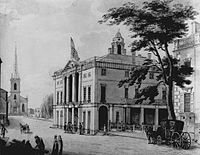Background
Under the provisions of the New York Constitution of 1777, the state senators were elected on general tickets in the senatorial districts, and were then divided into four classes. Six senators each drew lots for a term of 1, 2, 3 or 4 years and, beginning at the election in April 1778, every year six Senate seats came up for election to a four-year term. Assemblymen were elected countywide on general tickets to a one-year term, the whole assembly being renewed annually.
In March 1786, the legislature enacted that future legislatures meet on the first Tuesday of January of each year unless called earlier by the governor. No general meeting place was determined, leaving it to each Legislature to name the place where to reconvene, and if no place could be agreed upon, the legislature should meet again where it adjourned.
On February 7, 1791, the legislature had re-apportioned the Senate and Assembly districts, according to the figures of the 1790 United States census.
Matthew Clarkson resigned, leaving a vacancy in the Southern District; and John Williams was elected to Congress, leaving a vacancy in the Eastern District.
At this time the politicians were divided into two opposing political parties: the Federalists and the Democratic-Republicans. [1]
Sessions
The legislature was to meet at Federal Hall in New York City on January 5, 1796, but assembled a quorum only the next day. Both houses adjourned on April 11.
William North was re-elected Speaker with a vote of 29 against 18 for James Watson; both were Federalists. [2]
On February 12, 1796, the legislature divided the State into seven districts, in each of which an Assistant Attorney General [3] was to be the principal prosecuting officer, instead of the Attorney General and his deputy who had prosecuted statewide. The Attorney General continued to prosecute personally in New York City; the original Assistant Attorneys General appointed were: Nathaniel Lawrence, Jacob Radcliff, Ambrose Spencer, Anthony I. Blanchard, Abraham Van Vechten, William Stuart and Thomas R. Gold.
On March 4, 1796, the Legislature re-apportioned the Senate and Assembly districts, based on the figures of the New York State Census of 1795. The number of state senators was increased from 24 to 43; the number of assemblymen was increased from 70 to 108; the two-county Assembly districts were dismembered, and several new counties were created.
This page is based on this
Wikipedia article Text is available under the
CC BY-SA 4.0 license; additional terms may apply.
Images, videos and audio are available under their respective licenses.
